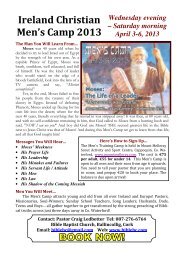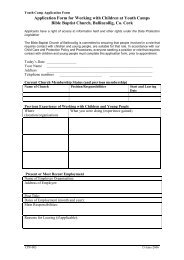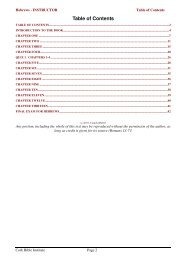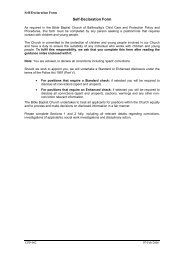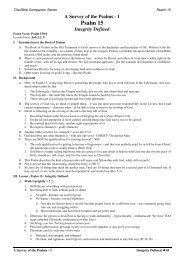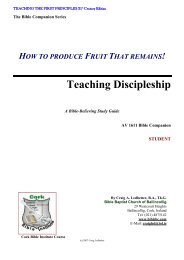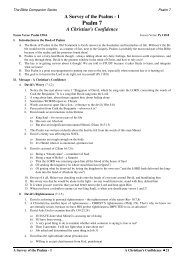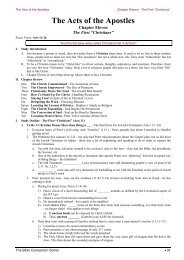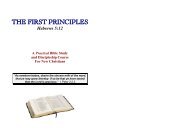An Introduction to Argumentation and Debate - Bible Baptist Church
An Introduction to Argumentation and Debate - Bible Baptist Church
An Introduction to Argumentation and Debate - Bible Baptist Church
You also want an ePaper? Increase the reach of your titles
YUMPU automatically turns print PDFs into web optimized ePapers that Google loves.
<strong>Argumentation</strong> <strong>and</strong> <strong>Debate</strong>Logic <strong>and</strong> Thinking Skills2. If a poll only asked 10 people for their opinions on a national election, the probabilitythat the conclusion would be true for the entire country would be very slim. (You willnotice that polls usually give a “margin of error” of a certain amount of percentagepoints. This margin of error exists because the conclusion of the poll is only probable,not certain.)D. As has already been said, you will mostly use inductive logic when making arguments inpolicy debate since you will be dealing with situations in which it is impossible <strong>to</strong> come <strong>to</strong>certain conclusions. But just because you will be using inductive logic doesn’t mean thatthere aren’t logical rules <strong>to</strong> follow. Modern British philosopher Stephen Toulmin,recognizing that people often cannot follow the strict guidelines of deductive logic, createda model <strong>to</strong> explain the rational construction of everyday arguments. The Toulmin model isvery helpful for debaters <strong>to</strong> follow, particularly in policy debate. Let’s take a look at themodel as it relates <strong>to</strong> debate.IV. THE TOULMIN MODELA. Toulmin has identified six parts of a rational argument: claim, data, warrant, backing,qualifications, <strong>and</strong> conditions of rebuttal. Rational arguments sometimes consist of all sixparts, but every part is not necessary <strong>to</strong> make a rational argument. Only the first three parts(claim, data, <strong>and</strong> warrant) are considered essential.B. CLAIM1. The claim is the argument you are trying <strong>to</strong> prove. Let's use the following claim as anexample:2. Homeschool students receive a higher-quality academic education than public schoolstudents.C. DATA1. Just because you've made a claim doesn't mean you've won an argument. You need <strong>to</strong>support the claim with evidence that helps prove your argument. How are you going <strong>to</strong>show that homeschool students' education is academically better than public schoolstudents'? You might use st<strong>and</strong>ardized achievement test results as a way <strong>to</strong> measure thetruth of your claim.2. You might say:Homeschooled students in the U.S. <strong>and</strong> Canada score 15 <strong>to</strong> 30 percentile points, onaverage, above their public school peers. This is true not only in the basics ofreading, writing, <strong>and</strong> mathematics, but also in science, social studies, <strong>and</strong> studyskills. * See "Ray, Dr. Brian D., Worldwide Guide <strong>to</strong> Homeschooling (Nashville:Broadman & Holman Publishers, 2005), 9.3. <strong>Debate</strong>rs use quotations from printed sources <strong>to</strong> provide the data for their claims. Here,you are using material from published studies <strong>to</strong> provide the data for your argument.This use of quotations from printed sources is what debaters call ________________.4. The amount of evidence you need <strong>to</strong> give <strong>to</strong> justify your data will vary with youraudience. If you are speaking at a homeschool convention where everyone is familiarwith these statistics, you may not even need <strong>to</strong> explicitly state your data. However, at aconvention of the National Education Association, you may have <strong>to</strong> provide asignificant amount of detailed evidence <strong>to</strong> prove your point. In a debate round, youshould provide evidence <strong>to</strong> back up anything that is not self-evident.Page 16





